INDIAN RED SELVEDGE C/L DENIM
弁柄 有機綿-麻 セルヴィッチデニム
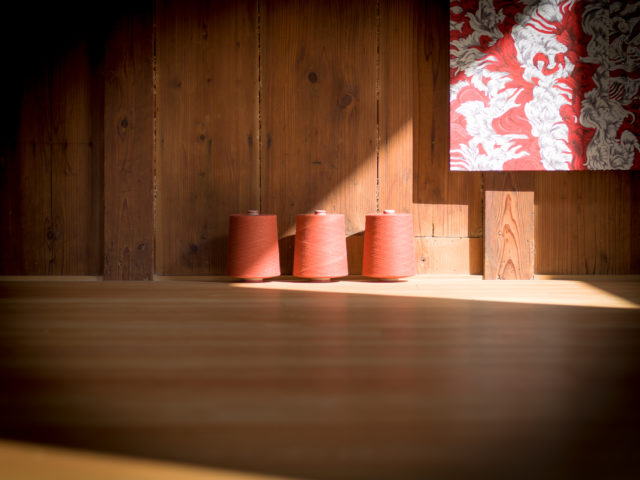
Philosophy-1
[Bengala = Indian red]
INDIAN RED SELVEDGE C/L DENIMにはベンガラと呼ばれる土から取れる酸化鉄が
主な成分の染料が使われています。
日本の暮らしにも古くから根付いている素材で陶器や漆器、瓦や、壁などの補強
や、防腐につかわれてきました。
特に岡山の吹屋町でとれるベンガラは焼いても綺麗な赤色が残るとされ、非常に
高貴な素材として重宝されてきました。
Our INDIAN RED SELVEDGE C/L DENIM uses a dye called Bengala, or Indian red, having iron oxide obtained from soil as its main ingredient.
The dye has been deeply rooted in the lives of the Japanese people for centuries, being used for the reinforcement and anti-corrosion treatment of pottery, lacquerware, roof tiles, walls, etc.
Bengala produced in Fukiya-machi, Tsuyama City, Okayama, in particular, has been treasured as an extremely valuable material for its beautiful red color even after heating.
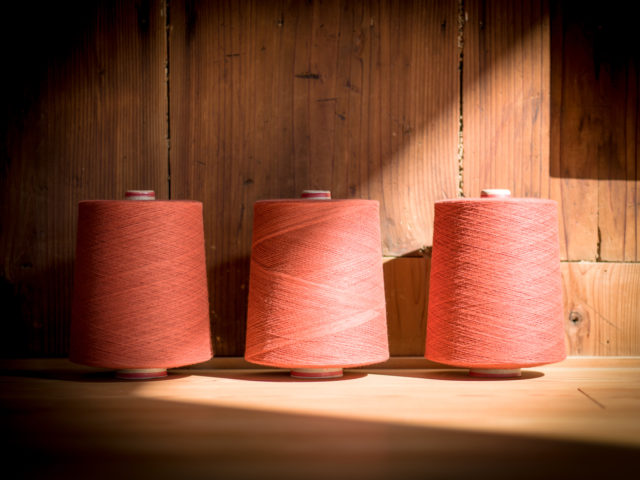
世界最古の顔料でもあり土から取れる大地の色はインディアンの顔を色鮮やかにペイントしてきました。
人類の暮らしの色を守り続けてきたこのベンガラを、
cottle のジーンズでは倉敷本染手織研究所の伝統的な織柄模様を入れて、
糸の段階から何度も手作業染色を繰り返し、色を定着させて、ジーンズの 耳と呼ばれる生地の端部分に織り込んでいます。
国産ジーンズ発祥である、倉敷市児島から、手工芸と工業製品の歴史の架橋となるジーンズを私達の手で生み出しています。
Bengala, the oldest pigment in the world taken from soil to represent the color of the earth, has been colorfully painting Native Americans’ faces.
Cottle jeans use this Bengala dye that has represented the color of people’s living. Yarns are repeatedly hand-dyed for setting colors, and by incorporating traditional woven patterns designed by the Kurashiki Dyeing, Spinning & Weaving Studio, they are then woven into the edge of the material called selvedge.
From Kojima, Kurashiki City, the birthplace of domestic jeans, we handmake jeans to bridge between the histories of handicrafts and industrial products.

Philosophy-2
[Tack button]
一般的な金属プレスのボタンではなく、
鋳造キャストで成型したピューター(錫(すず))の
オリジナルタック釦は、繁栄を表す縁(円)繋ぎ模様とCOTTLEのマークが、
鋳造で出来るもっとも細い線で立体的に彫刻されています。
This is not a standard metal press button, but an original pewter-cast button. A ring consisting of overlapping circles symbolizing prosperity and the COTTLE logo are etched three-dimensionally with the finest lines that can be ever casted.

よく目を凝らして見てください、
円の重なりは上下に円と円が引っかかっている様に作り出されています。
鋳造とは鋳型に上から鉄を流し込んで成形していく方法で
日本では大仏を作るときに古来からこの方法が利用されています。
Take a closer look.
The overlapping circles are linked on the top and bottom.
Casting is a method of shaping by pouring melted iron into a mold, an ancient technique used in Japan to make large Buddha statues.
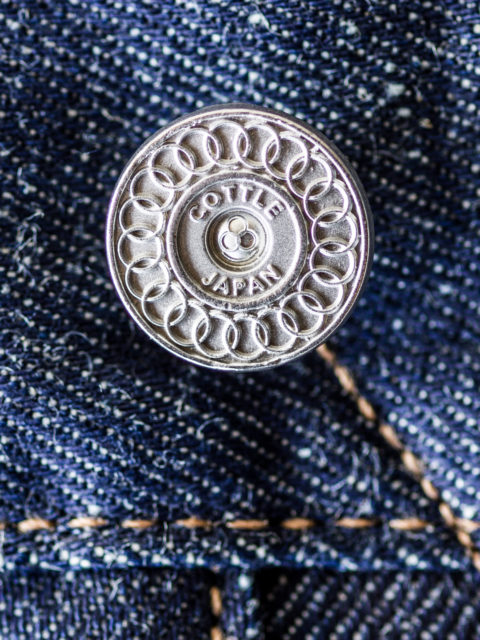
Philosophy-3
[Leather patch]
Tan leather tan-colored
経年変化が特徴的なヌメ色の厚みのある牛革にシュリンク加工(防縮)を施した
革パッチ
Tan leather color
This pre-shrunk leather patch uses a thick and tan-colored calfskin offering a distinctive aged quality.

Suede brown
KUDU(クードゥ)と呼ばれる、アンテロープ(2本角の牛)の革をクローム鞣しと
起毛加工を施したスエードパッチ
Suede brown
This suede patch is made from kudu leather of antelopes (two-horn cows) which is treated with chrome tanning and raising.
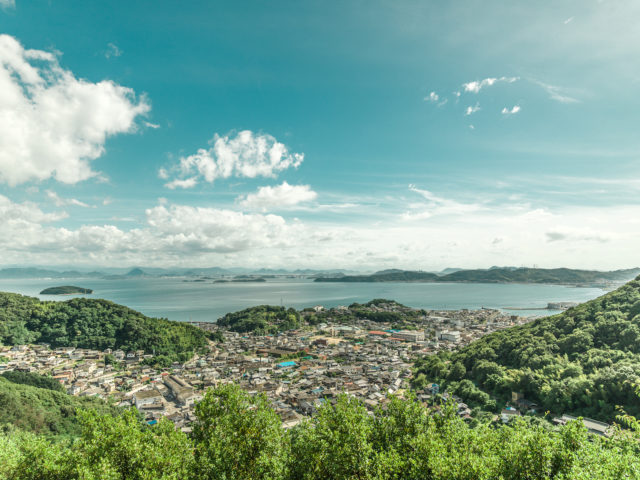
トシの妻であるゆかりさんが横浜からこの街に引っ越した際に見た、瀬戸内海に
浮かぶ可愛い島々を抽象的にデザインしています、
児島から見る瀬戸内海の風景には丸かったり、ポコッとした島が海に浮かんでいます
It is a symbolic design evoking lovely-looking islands in the Seto Inland Sea seen when Toshi’s wife, Yukari, moved to Kojima from Yokohama.
The scenery of the Seto Inland Sea as seen from this town features round and poppy islands floating in the sea.
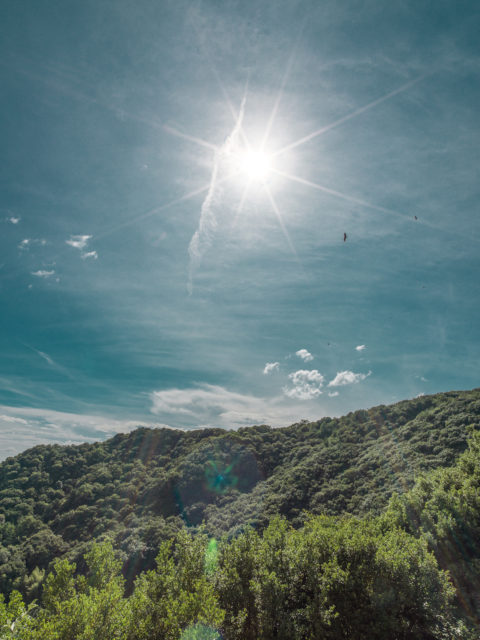

Philosophy-4
[Selvedge jeans]
セルヴィッチとはジーンズに使われる生地の耳(端)、部分の事を指します。
このジーンズのアイコンとも呼ばれる、デニムの耳の柄には民藝(みんげい)の父、
外村吉之介 (とのむらきちのすけ) 考案の藍と弁柄が美しく配列された伝統的模様がモチーフとされています。
モチーフの手織りタペストリーを初めて目にしたとき、自分の目指す削ぎ落とされた美しさをそこにみつけました。
Selvedge is the edge of the material used to make jeans.
The pattern of the edge of the denim, which is regarded as an icon of jeans, features, as a motif, a traditional pattern with a beautiful arrangement of Indigo and Bengala, an idea brought out by Kichinosuke Tonomura, known to be the father of “mingei” or folk art.
When first seeing a hand-woven tapestry motif, beauty in simplicity which had long been sought was found.
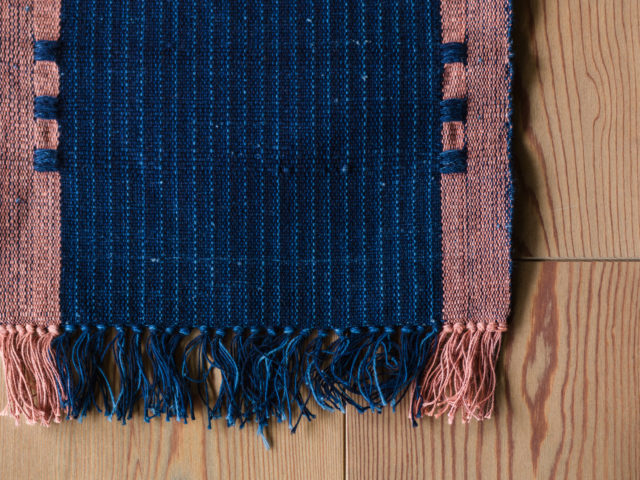
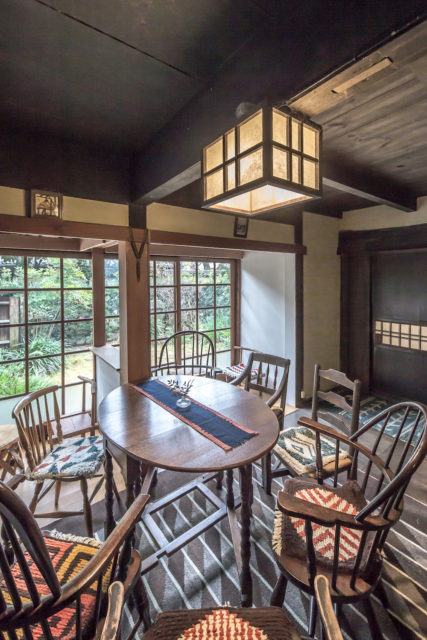
倉敷には倉敷本染手織研究所と呼ばれる、
日本一小さい学校と呼ばれる場所があります
女性のみが通う事が許され、
1年間下宿しながらものつくりを通して
生活の豊かさや知恵を,糸の染め織を通して学びます。
Kurashiki City has the Kurashiki Dyeing, Spinning & Weaving Studio which is called as the smallest school in Japan.
Only women are accepted to study and create, while living in a boarding house for a year. They learn the richness and wisdom of daily lives through dyeing, spinning and weaving.


日本では民藝と呼ばれるジャンルで
海外ではFOLK ARTと呼ばれたりしており、
現在ではその手作業の美しさや儚さが世界的に日常から生まれる芸術の一つとし
て見直されています。
This is a genre named “mingei” in Japan, which is called such as folk art in overseas countries. Today, the beauty and fragility of its handiwork is recognized worldwide as artwork born from daily lives.
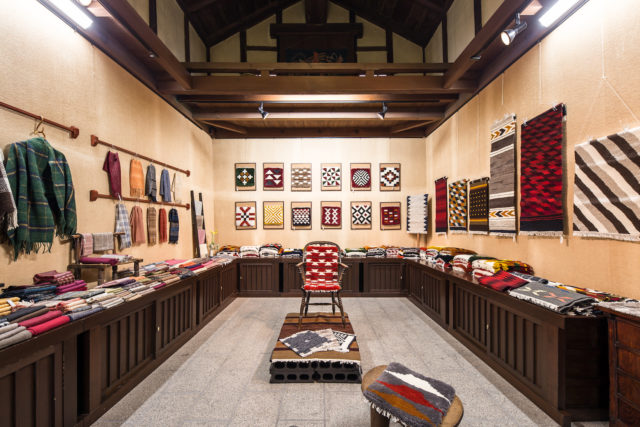

元々、同じ市内(倉敷)で活動されていた、倉敷本染手織研究所の活動に興味が
あり、
現,館長の石上先生に連絡を取り、ものつくりの思想に深く感銘を受けて、
一緒にお互いの技術を活かしてモノ作りを行う活動を提案した事がキッカケです。
手織りで織られた織物を現代的な洋服や小物として生まれ変わらす活動もそれ以
来、一緒に行っています。
Toshi was interested in activities of the Kurashiki Dyeing, Spinning & Weaving Studio in Kurashiki City where he is also based, and contacted Director Ishigami of the studio. Toshi was deeply impressed with Ishigami’s philosophy of monozukuri and proposed collaboration making use of each other’s skills.
They have been jointly recreating hand-woven fabric into modern clothing and accessories ever since.
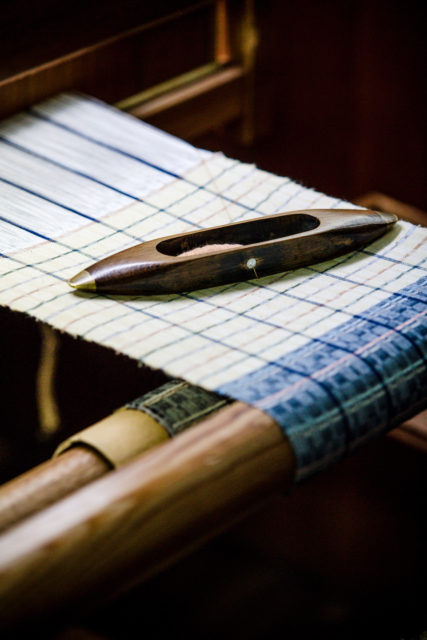

手工芸品や民藝品は機械で製造したものはNGですが、
同じ時代に岡山から大事に守られきた、繊維業と手工芸の、双方の歴史や伝統の
架け橋になるものが作りたいという思いから
手作業で何度も染色した弁柄染めの紬糸を工業製品のデニム生地に織り込んでい
ます。
Machinery cannot be used in the making of handicrafts and mingei items, but with the hope of becoming a bridge between the textile industry and handicrafts, as well as their history and tradition, which have been cherished in Okayama during the same period, spun threads are hand-dyed with Bengala dye repeatedly and used in the making of denim, an industrial product.
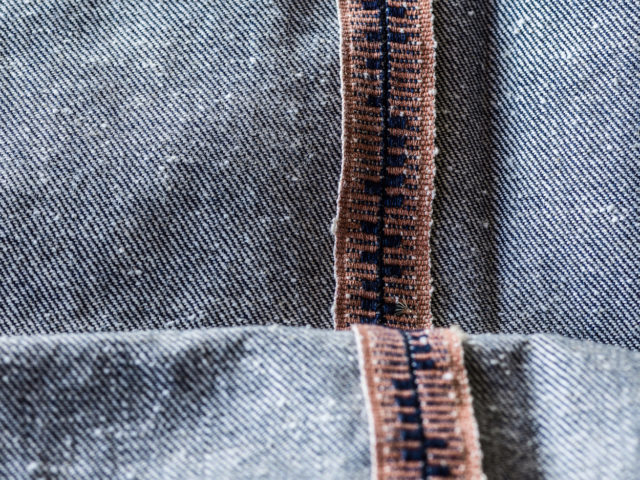

Philosophy-5
[Uniform for Living]
「何気ない日常生活の中にこそ、最高の贅沢は潜んでいる」
お気に入りのジーンズって、
生活を共にする相棒と同じ価値があると考えています。
時の変化をジーンズが記録してくれます。
かつてジーンズは労働者の作業着として開発されました。
現代にいたるまで、様々な時代を彩る先駆者の方達が、
ジーンズを時の変化の象徴として、自分のスタイルに取り入れてきました。
ジェームス・ディーン、マリリンモンロー、
アンディーウォホール、ジョンレノン、白洲次郎etc
“The ultimate luxury is in dressing casually every day.”
I think my favorite jeans are worth the same as my life partner. Jeans record changes in time.
Jeans were originally developed as work clothes for laborers. Pioneers of different ages have taken jeans into their style as an icon for changing times.
James Dean, Marilyn Monroe, Andy Warhol, John Lennon, Jiro Shirasu, etc.
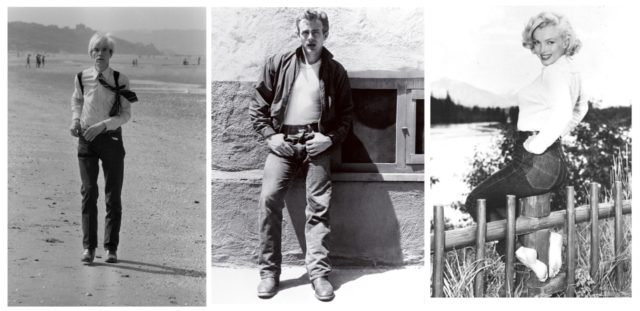
差別や、格差を切り開いてきたスーパースターは
いつもジーンズを相棒としてきました。
Superstars who have fought against discrimination and disparity have always used jeans as their partners.

cottleのジーンズもユニフォーム(正装着)のように崇高なスタイルを創るキッカ
ケになれば良いと考えます。
Cottle hopes that our jeans also provide an opportunity to create a sublime style like a uniform or formalwear.

Philosophy-6
[Material, or spinning, weaving, and dying]
ジーンズの製造業に勤めていた頃、糸の本数から色や風合い、重さなど、様々な
生地の開発に触れてきました。
いつも理想的なデニム生地を考えてはいたのですが、
cottleらしい、セルヴィッチタイプのジーンズに辿り着くまではおおよそ3年の
月日がかかりました
While once working for a jeans manufacturer, I was involved in the development of a wide variety of fabric having different numbers of threads, as well as varying in color, texture, and weight.
I was always thinking of ideal denim fabric, but it took us about three years to develop an original selvedge-type jeans, which is iconic to cottle.
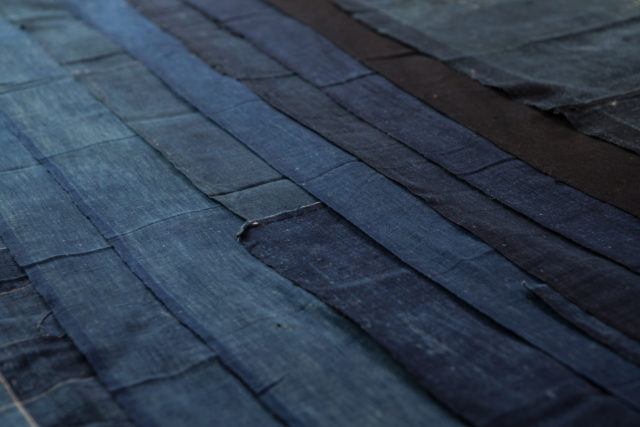

当初、綿が90%で麻10%の混率からなる14ozの素材をつくったのですが、自分のイ
メージとはわずかに離れていました。それから、改めて混率の調整、織り機の縦
糸と横糸の打ち込み本数などを見直し、様々な出会いと発見から、12ozセルビッ
チデニムの綿91%.麻9%のデニム生地に辿りつきました。
First we created 14oz material consisting of 90% cotton and 10% linen, which resulted in fabric slightly different from the image. We reviewed and adjusted a mixture composition, and the numbers of warp and weft threads. There were an array of encounters and discoveries, which resulted in 12oz selvedge denim fabric consisting of 91% cotton and 9% linen.
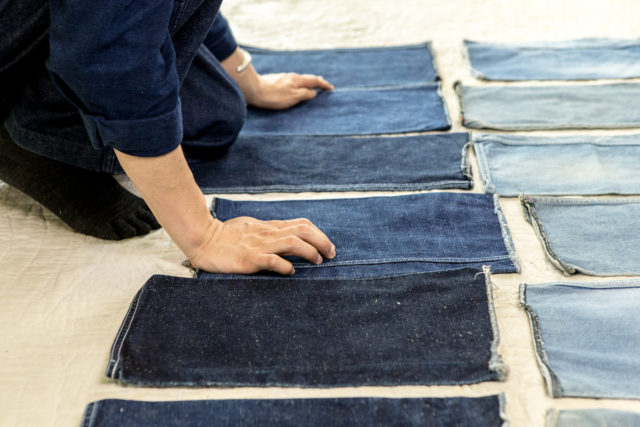
木綿の手紡ぎの様な、手織りの柔らかさや、雑味感、未完成感を出すために
麻の節の部分と綿のネップ部分を1本の糸に撚りあわせた、オリジナルの糸を一
から作りました。
To bring out softness, oddness and incompleteness of hand-spun cotton, we developed an original thread from scratch by twisting linen nep and cotton nep.
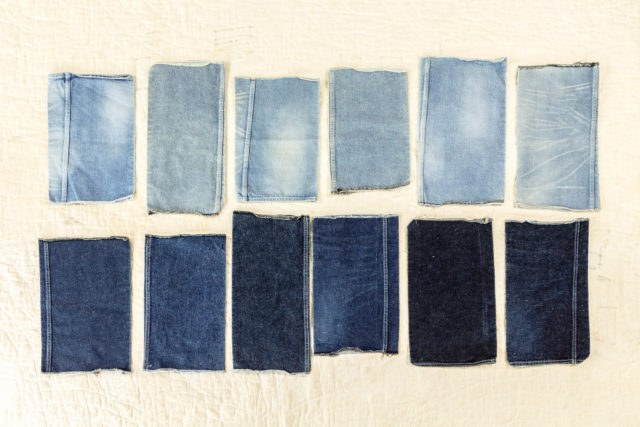
麻の節部分と綿のネップは相性良く、生地の表情を整える事ができ、
通常規格の無い太い糸を撚っている事で糸の間に空気を含む様な緩やかさが生ま
れました、
これにより、着用した際の立ち座りのしやすい、ストレッチ性が天然素材のみで
生まれています。
そうして、出来た糸を先程のベンガラ糸で織り上げた伝統的な柄織にドッキング
するという職人の技術が注がれています。
インディゴの色には国産ジーンズが生まれた時の初期ロットのジーンズの色味を
忠実に再現しており、
藍色の美しい色を彷彿させる鮮やかな色味は温故知新の精神を宿しています。
[ 麻-9% / オーガニックコットン-91% ]
Linen nep and cotton nep work well together, and they can tune up the impression of the fabric. Twisting unconventionally thick threads creates warmness that seems like enclosing air between the threads.
This resulted in stretchability for ease of sitting and standing when worn, using only natural materials.
Then skills of master craftsmen are put to combining these threads with traditional patterns woven with Bengala threads.
The indigo shade faithfully reproduces the hue of the initial lots of the first domestic jeans, and the vibrant tone which is a reminiscent of the beautiful indigo color represents the spirit of “studying the old to develop the new.”
[ MATERIAL – LINEN-9% / ORGANIC COTTON-91% ]

Published at: 2021-08-25


